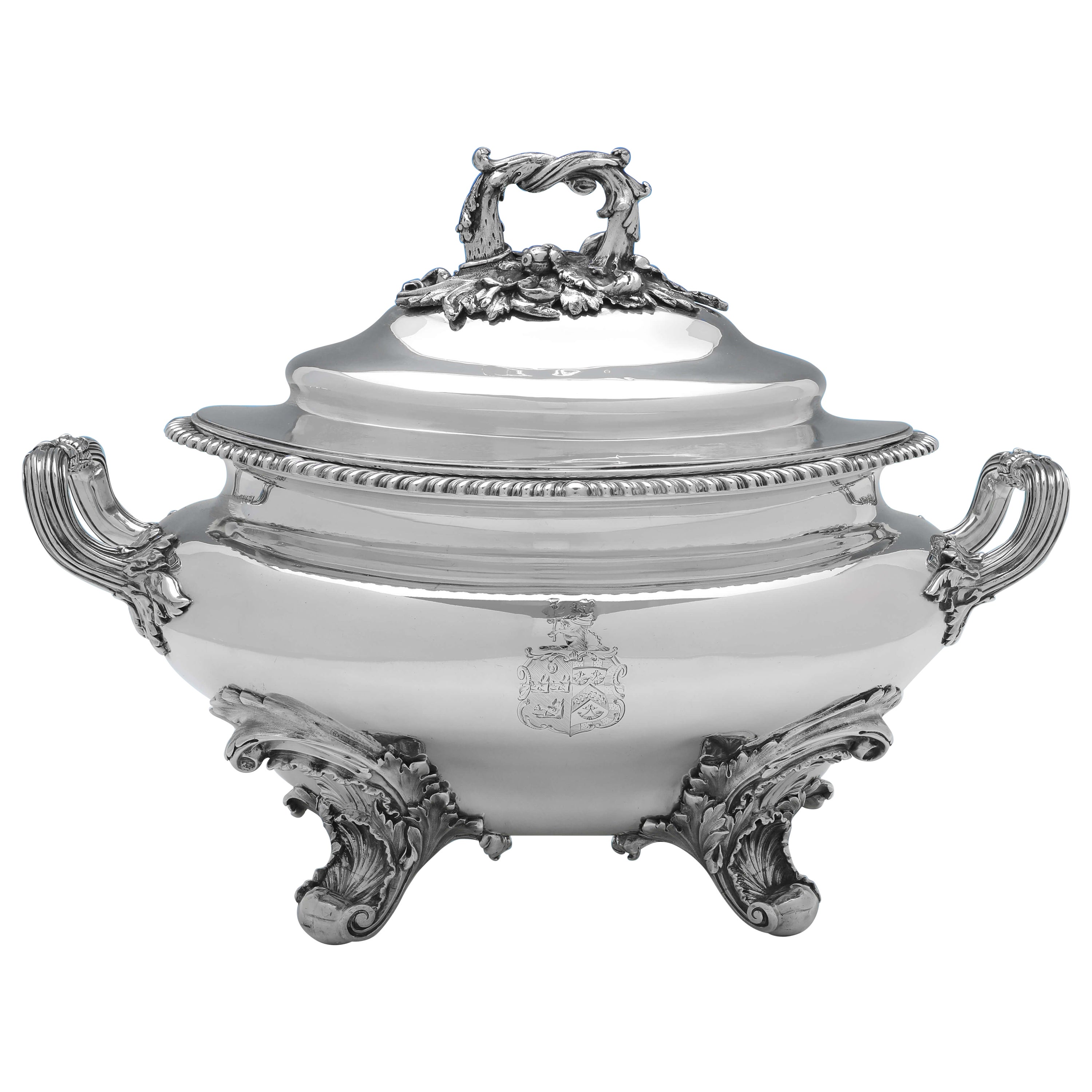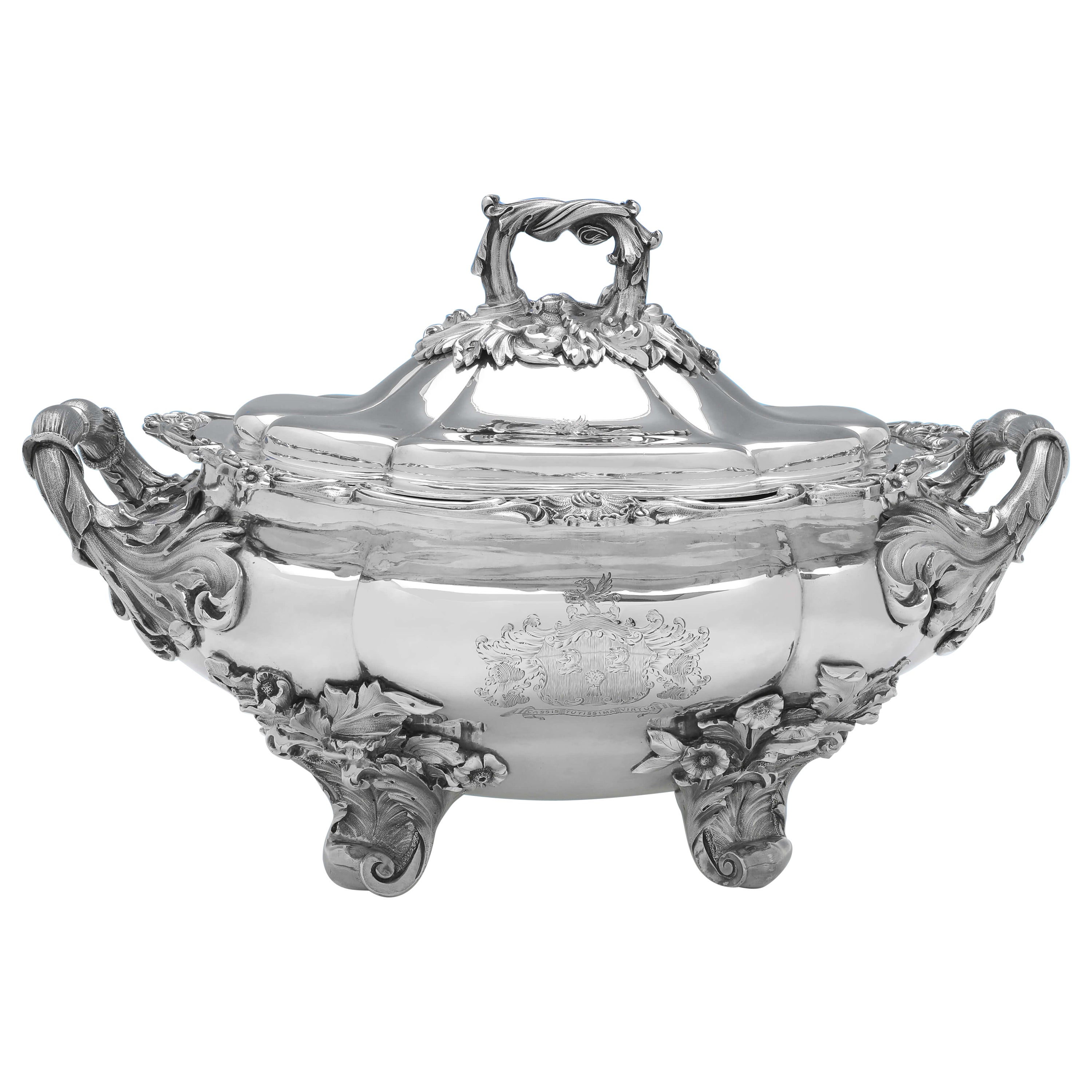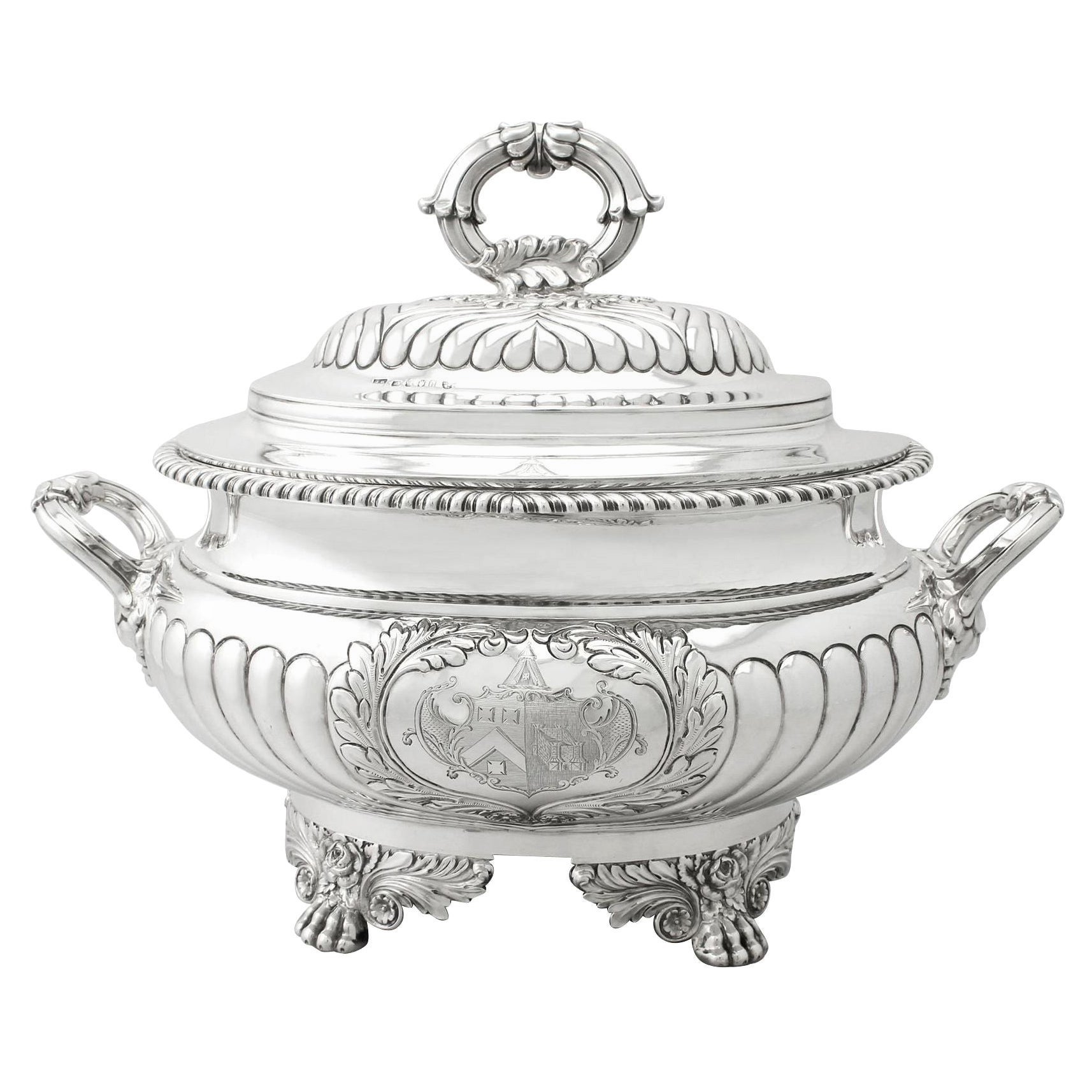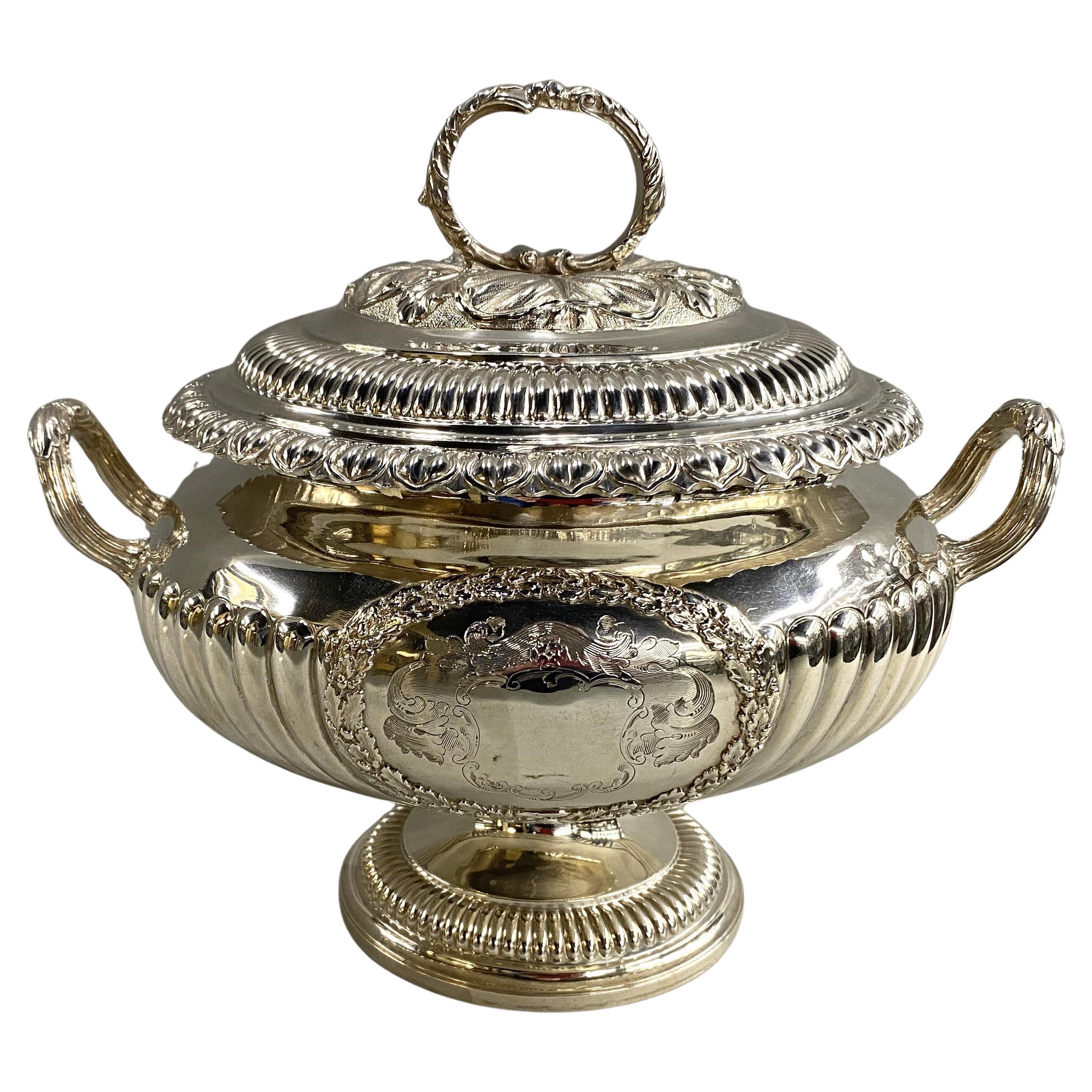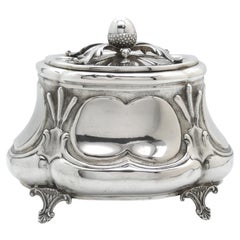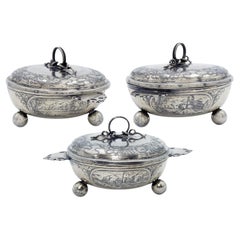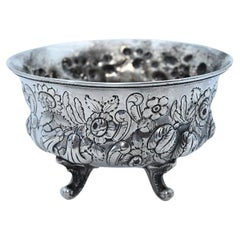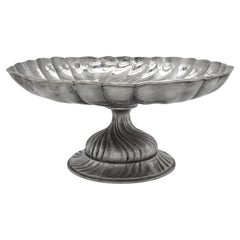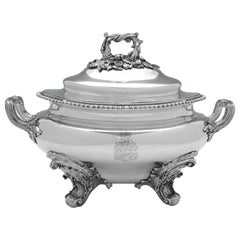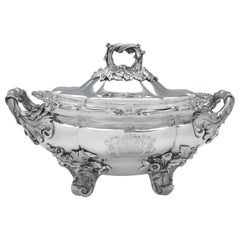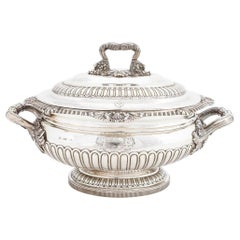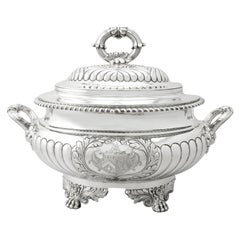Items Similar to An English Silver Soup Tureen made by Garrards, London 1827 Arms of Henry Paget
Want more images or videos?
Request additional images or videos from the seller
1 of 9
An English Silver Soup Tureen made by Garrards, London 1827 Arms of Henry Paget
$80,000
£61,432.32
€70,472.53
CA$112,409.39
A$125,891.42
CHF 65,688.08
MX$1,537,709.57
NOK 835,743.53
SEK 787,788.43
DKK 525,927.91
About the Item
A Magnificent English Silver Soup Tureen by Garrard’s, London, 1827
Bearing the Arms of Henry Paget, 1st Marquess of Anglesey, Hero of the Battle of Waterloo.
This splendid Regency-period silver soup tureen, made by the renowned royal silversmiths Garrard & Co., London, 1827, is a triumph of sculptural silver design, richly adorned and steeped in historical significance.
Of oval bombé form, this monumental tureen rests on four robust scroll feet with acanthus and shell embellishments. The body is flanked by a pair of elegantly cast and chased double-scroll handles, richly ornamented with floral terminals. The body is heavily embossed with swirling rococo cartouches and floral garlands, radiating drama and movement throughout its surface.
Prominently engraved on the front panel is the heraldic coat of arms and crest of Henry William Paget, 1st Marquess of Anglesey, framed by twin lions and topped by a coronet—an unmistakable mark of both noble lineage and national service. The domed cover, edged with rope-twist molding, is decorated with flowing panels of chased leaves and crowned with a naturalistic rose and bud finial, masterfully executed in the round.
This tureen is further distinguished by its original fitted silver insert, a rare and practical feature that underscores its noble provenance and functionality. The insert sits neatly inside the vessel, allowing the piece to serve both decorative and culinary purposes with regal elegance.
A truly museum-quality object, this tureen not only exemplifies Garrard’s technical and artistic excellence but also carries with it the legacy of a national hero.
Henry William Paget, 1st Marquess of Anglesey (17 May 1768 – 29 April 1854), styled Lord Paget between 1784 and 1812 and known as the Earl of Uxbridge between 1812 and 1815, was a British Army officer and politician. After serving as a member of parliament for Carnarvon and then for Milborne Port, he took part in the Flanders Campaign and then commanded the cavalry for Sir John Moore's army in Spain during the Peninsular War; his cavalry showed distinct superiority over their French counterparts at the Battle of Sahagún and at the Battle of Benavente, where he defeated the elite chasseurs of the French Imperial Guard. During the Hundred Days he led the charge of the heavy cavalry against Comte d'Erlon's column at the Battle of Waterloo. At the end of the battle, he lost part of one leg to a cannonball. In later life, he served twice as Master-General of the Ordnance and twice as Lord Lieutenant of Ireland.
Background, education and politics
He was born Henry Bayley, the eldest son of Henry Bayley-Paget, 1st Earl of Uxbridge and his wife Jane (née Champagné), daughter of the Very Reverend Arthur Champagné, Dean of Clonmacnoise, Ireland.[1] His father assumed the surname Paget in 1770. He was educated at Westminster School and Christ Church, Oxford.[2][3]
Paget entered parliament at the 1790 general election as member for Carnarvon,[3][4] a seat he held until the 1796 general election when his brother Edward was elected unopposed in his place.[4] He then represented Milborne Port from 1796 until he resigned his seat in 1804 by appointment as Steward of the Chiltern Hundreds,[5] and again from the 1806 election[6] to January 1810, when he took the Chiltern Hundreds again.[7]
Military career
The Marquess of Anglesey's Column at Llanfairpwllgwyngyll
At the outbreak of the French Revolutionary Wars, Paget raised a regiment of Staffordshire volunteers and was given the temporary rank of lieutenant-colonel-commandant in December 1793.[2][8] As the 80th Regiment of Foot, the unit took part in the Flanders Campaign of 1794 under Paget's command.[3] He was formally commissioned into the British Army as a lieutenant in the 7th Regiment of Foot on 14 April 1795[9] and received rapid promotion, first to captain in the 23rd Regiment of Foot, also on 14 April 1795,[10] then to major in the 65th Regiment of Foot, on 19 May 1795[11] and then to lieutenant-colonel in the 80th Regiment of Foot on 30 May 1795.[12] He transferred to the command of the 16th Light Dragoons on 15 June 1795.[13] Promoted to colonel on 3 May 1796,[14] he was given command of the 7th Light Dragoons on 6 April 1797.[15] He commanded a cavalry brigade at the Battle of Castricum in October 1799 during the Anglo-Russian invasion of Holland.[16]
Lord Paget by John Hoppner, 1798
Paget was promoted to major-general on 29 April 1802 and lieutenant-general on 25 April 1808.[17] He commanded the cavalry for Sir John Moore's army in Spain; his cavalry showed distinct superiority over their French counterparts at the Battle of Sahagún in December 1808, where his men captured two French lieutenant colonels and so mauled the French chasseurs that they ceased to exist as a viable regiment.[18] He also commanded the cavalry at the Battle of Benavente later in December 1808, where he defeated the elite chasseurs of the French Imperial Guard, and then commanded the cavalry again during the Retreat to Corunna in January 1809.[16] This was his last service in the Peninsular War, because his liaison with Lady Charlotte, the wife of Henry Wellesley, afterwards Lord Cowley, made it impossible subsequently for him to serve with Wellington, Wellesley's brother.[2][16] His only war service from 1809 to 1815 was in the disastrous Walcheren expedition in 1809,[2] during which he commanded an infantry division.[16] In 1810 he was divorced and then married Lady Charlotte, who had been divorced from her husband around the same time.[16] He inherited the title of Earl of Uxbridge on his father's death in March 1812 and was appointed a Knight Grand Cross of the Order of the Bath on 4 January 1815.[19]
Waterloo
During the Hundred Days he was appointed cavalry commander in Belgium, under the still resentful eye of Wellington.[16] He fought at the Battle of Quatre Bras on 16 June 1815 and at the Battle of Waterloo two days later, when he led the spectacular charge of the British heavy cavalry against Comte d'Erlon's column which checked and in part routed the French Army.[20]
One of the last cannon shots fired that day hit Paget in the right leg, necessitating its amputation.[16] According to anecdote, he was close to Wellington when his leg was hit, and exclaimed, "By God, sir, I've lost my leg!" – to which Wellington replied, "By God, sir, so you have!"[21] The earliest account is that given in the diary of J. W. Croker on 8 December 1818, quoting Horace Seymour who was next to Uxbridge when he was hit and helped move the wounded general from the field: "Rode with Horace Seymour. He was next to Lord Uxbridge when he was shot; he cried out: “I have got it at last.” And the Duke of Wellington only replied: “No? Have you, by God?""[22] According to his aide-de-camp, Thomas Wildman, during the amputation Paget smiled and said, "I have had a pretty long run. I have been a beau these 47 years and it would not be fair to cut the young men out any longer."[21]
'Lord Uxbridge's leg' became a tourist attraction in the village of Waterloo in Belgium, to which it had been removed and where it was later interred.[23] Paget had an articulated artificial limb fitted. The prosthetic legs he had commissioned (from one James Potts) which had movable joints became known as 'Anglesey legs' and he is credited with popularising the style. He became known as 'One-Leg'.[24]
Paget was created Marquess of Anglesey on 4 July 1815.[16] A 27-metre (89 ft) high monument to his heroism (designed by Thomas Harrison) was erected at Llanfairpwllgwyngyll on Anglesey, close to Paget's country retreat at Plas Newydd, in 1816.[25] He was also appointed a Knight of the Garter on 13 March 1818[26] and promoted to full general on 12 August 1819.[27]
Social life
Paget was the commodore of the Royal Irish Yacht Club, based at Sackville Street, Dublin (now O'Connell Street) in 1832 at the time when he served as lord-lieutenant of Ireland.[28]
Later career
Paget's support of the proceedings against Queen Caroline, alleging her infidelity, made him for a time unpopular, and when he was on one occasion beset by a crowd, who compelled him to shout "The Queen!", he added the wish, "May all your wives be like her".[1][29] At the coronation of George IV in July 1821, Paget acted as Lord High Steward of England.[29][30] He was also given the additional honour of captain of Cowes Castle on 25 March 1826.[31] In April 1827, he became a member of the Canningite Government, taking the post of Master-General of the Ordnance.[32] Under the Wellington ministry, he accepted the appointment of Lord Lieutenant of Ireland in February 1828.[33]
In December 1828, Paget addressed a letter to Patrick Curtis, the Roman Catholic primate of Ireland, stating his belief in the need for Catholic emancipation, which led to his recall by the government; on the formation of Earl Grey's administration in November 1830, he again became Lord-Lieutenant of Ireland.[29][16] In this capacity he introduced state-aided education for 400,000 children.[1] In July 1833, the ministry resigned over the Irish question. Still an impressive horseman even with a cork leg, George Whyte-Melville recalled the crowds that formed to cheer Paget as his well-ridden hack wended the London route from Piccadilly into Albemarle Street.[34] Paget spent the following thirteen years out of office, then joined Lord John Russell's administration as Master-General of the Ordnance in July 1846.[35] He was promoted to field-marshal on 9 November 1846[36] and, having been appointed Lord Lieutenant of Staffordshire on 31 January 1849,[37] he finally retired from the Government in March 1852.[38]
Paget also served as honorary colonel of the 7th Light Dragoons[39] and later of the Royal Horse Guards.[40] He died of a stroke at Uxbridge House in Burlington Gardens on 29 April 1854 and was buried at Lichfield Cathedral, where a monument is erected to his honour.[41] He was succeeded by his eldest son from his first marriage, Henry.[42]
Marriage and issue
Lady Caroline Villiers, (Lady Paget and later Duchess of Argyll), with her eldest son, Henry, by John Hoppner, 1800
Paget was first married on 5 July 1795 in London to Lady Caroline Elizabeth Villiers (16 December 1774 – 16 June 1835), daughter of George Bussy Villiers, 4th Earl of Jersey and Frances Villiers, Countess of Jersey. They had eight children:[42]
Lady Caroline Paget (6 June 1796 – 12 March 1874); married Charles Gordon-Lennox, 5th Duke of Richmond; they are ancestors of Diana, Princess of Wales.
Henry Paget, 2nd Marquess of Anglesey (6 July 1797 – 7 February 1869); married Eleanora Campbell, granddaughter of John Campbell, 5th Duke of Argyll
Lady Jane Paget (13 October 1798 – 28 January 1876); married Francis Conyngham, 2nd Marquess Conyngham.
Lady Georgina Paget (29 August 1800 – 9 November 1875); married Edward Crofton, 2nd Baron Crofton.
Lady Augusta Paget (26 January 1802 – 6 June 1872); married Arthur Chichester, 1st Baron Templemore.
Captain Lord William Paget RN (1 March 1803 – 17 May 1873); married Frances de Rottenburg, daughter of Francis de Rottenburg
Lady Agnes Paget (11 February 1804 – 9 October 1845); married George Byng, 2nd Earl of Strafford; they were parents to George Byng, 3rd Earl of Strafford, Henry Byng, 4th Earl of Strafford and Francis Byng, 5th Earl of Strafford
Lord Arthur Paget (31 January 1805 – 28 December 1825)
While Lady Paget recovered from the birth of their last child, Lord Paget
"paid her the kindest affectionate attentions yet from that period his love and affection for her as a wife seem to have been entirely estranged. While his Lordship lived in the same house sat at the same table and frequented the same Company with his wife he treated her person with the coldest indifference and neglect withholding all Connubial intercourse with her and constantly sleeping in a different room from her."[43]
Paget had in fact begun an affair with Lady Charlotte Wellesley (1781–1853), the wife of Henry Wellesley (brother of the Duke of Wellington)[44] and daughter of Charles Cadogan, 1st Earl Cadogan and Mary Churchill.
In November 1808, Paget went to Spain to fight in the Peninsular War, but on his return he and Lady Charlotte resumed their affair, and in March 1809 they scandalously eloped and began living together. On 28 March 1809, Lady Charlotte's brother, Henry Cadogan, challenged Paget to a duel:
"My Lord, I hereby request you to name a time and place where I may meet you, to obtain satisfaction for the injury done myself and my whole family by your conduct to my sister. I have to add that the time must be as early as possible, and the place not in the immediate neighbourhood of London, as it is by concealment alone that I am able to evade the Police."[45]
The contest took place on Wimbledon Common on the morning of 30 May with Hussey Vivian as Lord Paget's second and Captain McKenzie as Cadogan's. Both men discharged their pistols, honour was satisfied and the parties left the field uninjured.[46] Henry Wellesley had his marriage dissolved by private act of parliament in 1810 and sued Lord Paget for damages.[43]
By this time, Caroline, Lady Paget, had fallen in love with the Duke of Argyll, and was equally eager to divorce Lord Paget. However, she was unable to obtain a divorce in England,[43] as only husbands could seek a bill of divorce on the grounds of adultery alone; for wives, the adultery was required to be compounded by "life-threatening cruelty."[47]
The Pagets took advantage of Scots law to get an expedited divorce. Lord Paget stayed together at hotels in Edinburgh and Perthshire, where they were witnessed in bed together by chambermaids. However, if Lady Charlotte had been identified by name she would not have been able to marry Lord Paget under Scottish law, and she "positively refus'd letting Lord Paget domiciliate with any other woman", so the couple concealed her identity so the witnesses could attest they had no idea of the identity of the woman whom they saw with Lord Paget. It was said she "eat, drank, and slept in a black veil".[43]
Maker: Garrard & Co., London, 1827
Marks: Fully hallmarked
Total weight ( including silver insert): 5260 grams
To view other items owned by Henry Paget, see:
Sotheby's Treasures Auction, on December 10,
An impressive pair of George IV five-light silver candelabra, Robert Garrard, London, 1827
And:
Christie's The Exceptional Sale, on July 4,
THE Marquess of Anglesey's Candelabra, a pair of George III Silver Two-Light Candelabra
Mark of John Wakelin and William Taylor, London, 1792
- Dimensions:Height: 10.24 in (26 cm)Width: 15.75 in (40 cm)Depth: 9.45 in (24 cm)
- Materials and Techniques:Silver,Engraved
- Place of Origin:
- Period:
- Date of Manufacture:1827
- Condition:Wear consistent with age and use.
- Seller Location:New York, NY
- Reference Number:1stDibs: LU5281245125362
About the Seller
5.0
Recognized Seller
These prestigious sellers are industry leaders and represent the highest echelon for item quality and design.
Established in 2006
1stDibs seller since 2020
131 sales on 1stDibs
Typical response time: 1 to 2 days
- ShippingRetrieving quote...Shipping from: Antwerpen, Belgium
- Return Policy
Authenticity Guarantee
In the unlikely event there’s an issue with an item’s authenticity, contact us within 1 year for a full refund. DetailsMoney-Back Guarantee
If your item is not as described, is damaged in transit, or does not arrive, contact us within 7 days for a full refund. Details24-Hour Cancellation
You have a 24-hour grace period in which to reconsider your purchase, with no questions asked.Vetted Professional Sellers
Our world-class sellers must adhere to strict standards for service and quality, maintaining the integrity of our listings.Price-Match Guarantee
If you find that a seller listed the same item for a lower price elsewhere, we’ll match it.Trusted Global Delivery
Our best-in-class carrier network provides specialized shipping options worldwide, including custom delivery.More From This Seller
View AllClassic Silver Etrog Container, Poland Second Half 19th Century
Located in New York, NY
This Classic Silver Etrog Container from Poland, dating to the second half of the 19th century, is a beautiful example of Jewish ceremonial art. This container, designed to hold the ...
Category
Antique 19th Century Polish Sterling Silver
Materials
Silver
$2,240 Sale Price
20% Off
A Silver Gilt Engraved Bowl and Matching Cover, Augsburg circa 1700
Located in New York, NY
A superb example of late 17th to early 18th-century German silverwork, this magnificent silver-gilt covered bowl was crafted in Augsburg circa 1700 by the accomplished silversmith Jo...
Category
Antique Early 1700s German Sterling Silver
Materials
Silver
An American Fruit Bowl, New York 19th Century by W.Adams
Located in New York, NY
A striking example of 19th-century American silverwork, this elegant silver bowl was crafted in New York by noted silversmith W. Adams, whose refined craftsmanship is beautifully dis...
Category
Antique 19th Century American Sterling Silver
Materials
Silver
A Silver Tazza by Lazarus Posen Early 19th Century
By Lazarus Posen Witwe
Located in New York, NY
A Lovely Silver Tazza by Lazarus Posen from the early 19th century is a notable and historically significant piece in the world of Judaica.
Lazarus Posen was a renowned silversmith ...
Category
Antique Early 19th Century German Sterling Silver
Materials
Silver
$1,440 Sale Price
20% Off
A Silver Filigree Basket, Poland mid-19th Century
Located in New York, NY
A Silver Filigree Basket made in Poland in the mid-19th Century.
Filigree designed basket was used to contain horseradish complete with a small filigree serving spoon.
Set on Four ...
Category
Antique Mid-19th Century Polish Sterling Silver
Materials
Silver
$1,040 Sale Price
20% Off
An Early 19th Century Polish Silver Spice Container
Located in New York, NY
An early 19th-century Polish spice container, like this one which was used for the Jewish ritual of Havdalah, reflects both the cultural and religious practices of Polish Jewry durin...
Category
Antique Early 19th Century Polish Sterling Silver
Materials
Silver
$3,040 Sale Price
20% Off
You May Also Like
William IV Period Antique Sterling Silver Soup Tureen - London 1835 - Barnards
By Barnards
Located in London, London
Hallmarked in London in 1835 by Barnards, this superb, William IV, Antique Sterling Silver Soup Tureen, features an ornate cast handle to the lid and ornate cast feet, a gadroon bord...
Category
Antique 1830s English William IV Sterling Silver
Materials
Sterling Silver
Stunning George IV Antique Sterling Silver Soup Tureen - London 1827
Located in London, London
Hallmarked in London in 1827 by Benjamin Preston, this incredible, Antique Sterling Silver Soup Tureen, is a masterpiece of the regency style, with cast and applied feet and handles,...
Category
Antique 1820s English Regency Sterling Silver
Materials
Sterling Silver
Armorial Sterling Silver Tureen, London, circa 1817
Located in Atlanta, GA
Joseph Craddock and William Ker Reid, 1817. Sterling silver lidded George III tureen bearing Langton family coat of arms. Appropriately marked. Dimensions: Height 10 3/4" x width 16"...
Category
Antique Early 19th Century English George III Soup Tureens
Materials
Silver
Antique Sterling Silver Soup Tureen or Centerpiece
By James Barber & William Whitwell
Located in Jesmond, Newcastle Upon Tyne
A magnificent, fine and impressive, rare antique George IV English sterling silver soup tureen assayed in York; an addition to our dining silverware collection.
This magnificent antique George IV English sterling silver soup tureen has an oval rounded form.
The lower portion of the body is encompassed with impressive chased fluted decoration in a subtle swirl design.
The decoration to the body incorporates an impressive scrolling leaf bordered cartouche to either side, each displaying an exceptional contemporary bright cut engraved marital coat of arms* depicting on the dexter a chevron between three crosses paty and the sinister a quadrangular castle.
The coat of arms is surmounted with a bright cut engraved crest displaying a tent adorned or lined charged in the interior with a cross paty of the third.
The plain waisted upper portion is encompassed with a Fine and impressive applied gadroon decorated border to the flared rim.
This antique soup tureen...
Category
Antique 1820s English George IV Sterling Silver
Materials
Silver, Sterling Silver
1871 Victorian Sterling Silver Soup Tureen
By Martin, Hall & Co. Ltd.
Located in Jesmond, Newcastle Upon Tyne
An exceptional, fine and impressive, large antique Victorian English sterling silver soup tureen; an addition to our dining silverware collection
This exceptional antique Victoria...
Category
Antique 1870s English Victorian Serving Bowls
Materials
Silver, Sterling Silver
George IV Sterling Silver Covered Soup Tureen, Samuel Hennell, London c 1822
By Samuel Hennell
Located in Milford, NH
An exceptional sterling silver covered soup tureen with a compressed round body, decorated with flutes, two leaf capped handles, oak leaves, and acorns border two reserves. The base ...
Category
Antique 1820s English George IV Soup Tureens
Materials
Sterling Silver
More Ways To Browse
Hotel Silver
Articulated Silver
Sterling Silver Spain
Antique Duchess
Antique Scottish Silver
Sterling Silver Champagne
Crown Silver Company
Coat Of Arms Lions
Twisted Rope Glass
Silver Cow
Sterling Silver Horse
Henry Iv
Dutch Engraved Glass
Antique Cathedral Glass
Glass Cow
Table With Coat Of Arms
Roman Candelabras
Crown Silver Co
